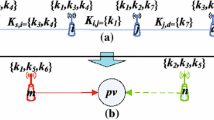Abstract
The resource exploitation is inhibited in the huge region of WSN (Wireless Sensor Network) and various attacks are introduced in vast vulnerable network. The intruder seizes the sensor vertices (nodes) and pilfers the secret data to control laudatory WSN under the node capture attack. We develop a Black Widow Optimization Algorithm (BWOA) to discover the sensor vertices having superior possibility of compromising by attack. BWOA is applied on multi objective function combining the various factors such as link key utilization, link stability time, link participation and link energy expenses of vertices and experiment results illustrate the superior performance of BWOA in terms of energy expenses cost, rounds of attack, compromised portion of traffic and complexity against MA, FGA, MREA, ACO and PSO.
Access this chapter
Tax calculation will be finalised at checkout
Purchases are for personal use only
Similar content being viewed by others
References
H.R. Shaukat, F. Hashim, M.A. Shaukat, K.A. Alezabi, Hybrid multi-level detection and mitigation of clone attacks in Mobile Wireless Sensor Network (MWSN). Sensors, MDPI 20, 1–23 (2020)
Xiong C., Li S., Liu L., Li R. and Jin Y.: A Hybrid Key Pre-distribution Scheme for Wireless Sensor Networks. IOP Conf. Series, Journal of Physics, pp. 1–18, (2019). (doi:https://doi.org/10.1088/1742-6596/1229/1/012066)
I.Q. Kolagar, H.H.S. Javadi, M. Anzani, Hypercube bivariate-based key management for wireless sensor networks. J. Sci., Islamic Repub. Iran, Univ. Tehran. 28(3), 273–285 (2017)
B. Butani, P.K. Shukla, S. Silakari, An exhaustive survey on physical node capture attack in WSN. Int. J. Comput. Appl. 95(3), 32–39 (2014)
G. Wu, X. Chen, M.S. Obaidat, A high efficient node capture attack algorithm in wireless sensor network based on route minimum key set. Secur. Commun. Netw. 6, 230–238 (2013)
S. Hong, S. Lim, Analysis of attack models via unified modeling language in wireless sensor networks: A survey study. IEEE, 692–696 (2010)
P. De, Y. Liu, S.K. Das, Deployment aware modeling of node compromise spread in wireless sensor networks using epidemic theory. ACM, 1–29 (2008)
A. Albakri, L. Harn, S. Song, Hierarchical Key Management Scheme with Probabilistic Security in a Wireless Sensor Network (WSN). Secur. Commun. Netw., Hindawi, 1–11 (2019). (https://doi.org/https://doi.org/10.1155/2019/3950129)
J.W. Ho, Distributed detection of node capture attacks in wireless sensor networks. Intechopen, 345–363 (2010)
C. Lin, G. Wu, Enhancing the attacking efficiency of the node capture attack in WSN: A matrix approach. J. Supercomput. (Springer Science & Business Media), 1–19 (2013). https://doi.org/10.1007/s11227-013-0965-0
C. Lin, G. Wu, C.W. Yu, L. Yao, Maximizing destructiveness of node capture attack in wireless sensor networks. J. Supercomput. (Springer Science & Business Media) 71, 3181–3212 (2015). https://doi.org/10.1007/s11227-015-1435-7
C. Lin, T. Qiu, M.S. Obaidat, C.W. Yu, L. Yao, G. Wu, MREA: A minimum resource expenditure node capture attack in wireless sensor networks. Secur. Commun. Netw. (Wiley Online Library) 9, 5502–5517 (2016). https://doi.org/10.1002/sec.1713
D. Molina, J. Poyatos, J.D. Ser, S. Garcia, A. Hussain, F. Herrera, Comprehensive Taxonomies of Nature- and Bio-inspired Optimization: Inspiration versus Algorithmic Behavior, Critical Analysis and Recommendations. cs.AI, pp. 1–76, (2020). (arXiv:2002.08136v2)
R. Bhatt, P. Maheshwary, P. Shukla, P. Shukla, M. Shrivastava, S. Changlani, Implementation of Fruit Fly Optimization Algorithm (FFOA) to escalate the attacking efficiency of node capture attack in Wireless Sensor Networks (WSN). Comput.Commun. (Elsevier) 149, 134–145 (2020)
P.K. Shukla, S. Goyal, R. Wadhvani, M.A. Rizvi, P. Sharma, N. Tantubay, Finding Robust Assailant Using Optimization Functions (FiRAO-PG) in Wireless Sensor Network (Hindawi Publishing Corporation, Mathematical Problems in Engineering, 2015), pp. 1–8. (http://doi.org/https://doi.org/10.1155/2015/594345)
Author information
Authors and Affiliations
Corresponding author
Editor information
Editors and Affiliations
Rights and permissions
Copyright information
© 2021 The Author(s), under exclusive license to Springer Nature Singapore Pte Ltd.
About this paper
Cite this paper
Khare, A., Gupta, R., Shukla, P.K., Chowdhury, R., Datta, P.K. (2021). A Black Widow Optimization Algorithm (BWOA) for Node Capture Attack to Enhance the Wireless Sensor Network Protection. In: Balas, V.E., Hassanien, A.E., Chakrabarti, S., Mandal, L. (eds) Proceedings of International Conference on Computational Intelligence, Data Science and Cloud Computing. Lecture Notes on Data Engineering and Communications Technologies, vol 62. Springer, Singapore. https://doi.org/10.1007/978-981-33-4968-1_47
Download citation
DOI: https://doi.org/10.1007/978-981-33-4968-1_47
Published:
Publisher Name: Springer, Singapore
Print ISBN: 978-981-33-4967-4
Online ISBN: 978-981-33-4968-1
eBook Packages: Intelligent Technologies and RoboticsIntelligent Technologies and Robotics (R0)




